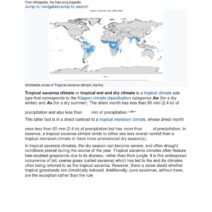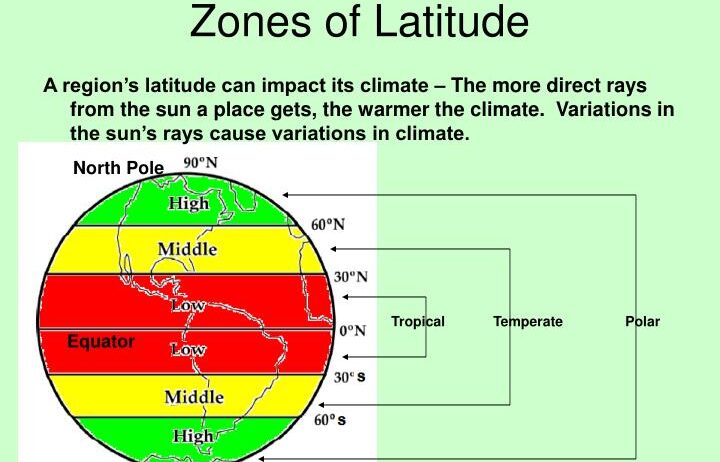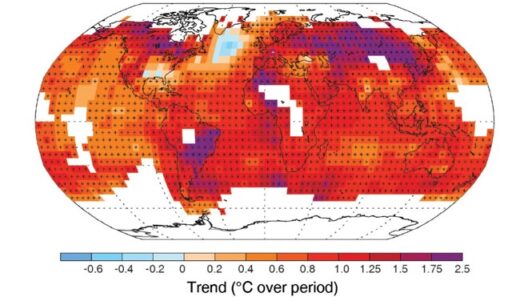Latitude, the angular distance from the equatorial plane, serves as a formidable architect of our planet’s climate. It weaves an intricate tapestry across the globe with varying patterns of temperature, precipitation, and ecosystems, creating a mosaic of climatic zones. Understanding how latitude influences climate is not only critical for comprehending our environment but also essential for addressing global challenges such as climate change and biodiversity loss.
As we venture to decode this complexity, we will traverse the globe’s latitudinal divide, exploring distinct climate zones and the factors that underlie them. Let’s embark on this expedition from the scorching equator to the icy poles, illuminating the unique characteristics and appeals of these diverse climatic spheres.
Climate Zones: A Dance of Heat and Light
At the core of the latitude-climate relationship lies the sun’s uneven distribution of heat. The equator, bathed in direct sunlight all year round, finds itself in the embrace of the tropics. Here, the tropical climate flourishes, characterized by high temperatures and abundant rainfall. The tropics are the garden of the Earth; they host lush rainforests brimming with biodiversity, where the pulse of life beats in tandem with the rhythm of seasonal monsoons. This zone is akin to a vibrant artist’s palette, bursting with colors of flora and fauna, where each hue whispers the secrets of adaptation and resilience.
As we drift northward and southward from the equator, the intensity of solar energy diminishes. The temperate zones emerge, each exhibiting a unique climatic signature. These regions are like the delicate balance of a maestro conducting a symphony, where the seasons—spring, summer, autumn, and winter—play their respective parts in an annual performance. Here, the climate is moderate, with seasonal variations that influence agricultural cycles, biodiversity, and human settlements. The temperate zones are a testament to nature’s versatility, where fertile fields yield bountiful crops in summer and snow-clad landscapes evoke the tranquility of winter serenity.
Yet, beyond the temperate compass lies a stark transition. As we ascend towards the polar regions, we enter the realm of cold and desolation. In the Arctic and Antarctic climates, frigid temperatures reign supreme, and daylight becomes an ephemeral phenomenon. The unyielding cold breathes life into uniquely adapted ecosystems inhabited by polar bears, penguins, and myriad species that thrive in conditions that most would deem inhospitable. This extreme climate serves as a reminder of Earth’s resilience and adaptability, challenging the species that inhabit these regions to exhibit extraordinary evolutionary strategies for survival.
The Role of Ocean Currents in Modulating Climate
Latitude alone does not dictate climate; it is a complex interplay of factors where ocean currents serve as powerful allies or adversaries. The oceans, vast and mysterious, absorb solar energy and redistribute it across the globe, significantly impacting regional climates. Warm currents, like the Gulf Stream, transport heat from the equatorial regions to higher latitudes, thus tempering the chill of temperate zones and even having a moderating effect on some polar areas. Conversely, cold countercurrents can plunge temperatures and induce harsher climates, making certain coastal regions stark contrasts to adjacent landmasses.
This dance of ocean currents is a masterclass in climate dynamics. Coastal cities nestled in the embrace of warm currents enjoy milder winters and balmy summers, while those buffeted by cold currents must contend with a more rigorous climate. The ocean continues to shape the destinies of nations, influencing agriculture, human migration, and economic prosperity. This watery web connects climates across vast distances, echoing the intricate relationships that define our world.
Implications of Latitude on Climate Change
While latitude paints a colorful picture of Earth’s climate canvas, it is critical to recognize that these natural systems face unprecedented challenges due to climate change. The warming of the planet is not uniform; its impacts vary dramatically across different latitudes, leading to a reshuffling of climate zones and ecological consequences that ripple throughout the globe.
In the tropics, increased temperatures can exacerbate deforestation and threaten biodiversity, while the temperate zones grapple with shifting seasons that disrupt agricultural patterns and traditional practices. The polar regions, however, face some of the most acute changes, as melting ice caps and thawing permafrost not only raise sea levels but also release stored carbon, further accelerating global warming.
As the interplay between latitude and climate evolves, human populations must adapt to these varying conditions, fostering resilience through innovative practices and sustainable solutions. Whether through adopting climate-smart agricultural techniques in temperate zones or advocating for conservation efforts in the polar regions, understanding the latitudinal impacts fosters a sense of urgency to protect our planet’s diverse environments.
The journey through latitude and climate elucidates an intricate relationship that shapes our world. From the equator’s vibrant tropics to the polar extremes, the tapestry of climate zones reflects Earth’s pluralistic beauty and highlights the need for conscientious stewardship. In this age of climate change, recognizing the significance of latitude is paramount—not just for scientific inquiry but for the future of humanity in its bid to harmonize with nature’s rhythm.






